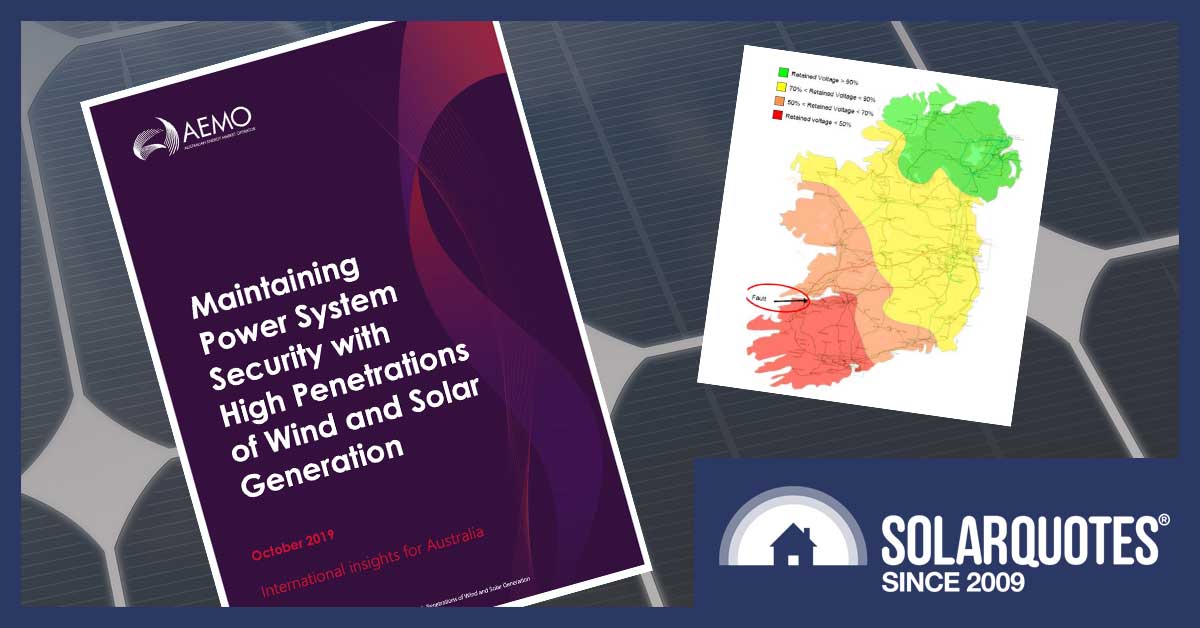
Worried that Australia’s grid will collapse with too many renewables? Ireland has shown – as long as we have a carefully ‘staged transition’ – the risks are manageable.
The Australian Energy Market Operator (AEMO) is trying to understand what might be what it calls the “upper limits” of wind and solar energy deployment into the Australian grid. In a report published this week, it has presented the first stage of its Renewable Integration Study.
The report (PDF) compared Australia’s renewable integration to international markets; analyses system aspects specific to wind and solar energy (variability, frequency control, and distributed energy resource growth), and takes a good hard look in the crystal ball for the National Energy Market (NEM) over the next decade. The NEM analysis, AEMO wrote, has to take into account “the more localised limits to wind and solar PV penetration (for example, network congestion and localised system strength)”.
On the international stage, AEMO reckons there are some parts of Australia that lead the world in renewable deployment, but that we need to learn from overseas markets to achieve the “visibility, predictability, and controllability” needed to integrate systems like rooftop solar power into the grid (as we’ve discussed previously, energy providers like SA Power are well aware of the challenges).
At the summary level, AEMO highlighted international experience in “the assessment of system ramping requirements and fleet capability”, in frequency management and inertia control in high renewable scenarios.
And, as our friends over at Renew Economy highlighted, the report also hints that AEMO is interested in which it calls a “staged approach” to bringing “less synchronous” generation online.
Most of the challenges raised by AEMO – frequency management, variability, voltage management, and DER integration – are fairly well known, so I’m going to drill into what AEMO has in mind when it talks about the “staged transition”.
When The Transition Goes Wrong
Its international examples are:
- Great Britain and Ireland, where the approach to generation protection “created a risk of a co-ordinated loss of generation that could collapse the system”;
- Germany, which is having to retrofit “hundreds of thousands” of inverters to get the visibility it needs; the general problem of DER systems disconnecting themselves if there’s a system disturbance; and
- South Australia’s notorious and widely-misunderstood blackout, partly because wind farm protection settings took them offline “after experiencing a number of successive voltage dips”.
Ireland’s EirGrid is the only staged transition AEMO cited, so that gives us the best insight into AEMO’s thinking. In deciding how to relax its operational limits, the report says, EirGrid uses the following process:
- Detailed analysis leading to a report outlining a provisional operating strategy;
- If an Operation Policy Review Committee accepts the report, it will give approval, setting out the “operational defensive measures” it requires (which might include “new control centre tools, policies, and mitigating key risks”);
- EirGrid confirms stable operation, and if that’s not achieved, it will revert to its previous official policy;
- After around three months – 100 hours of running – “ex post sensitivity studies are completed to analyse system resilience”; and
- The OPRC determines the success of the trial.
“Australia can learn from the staged transition Ireland has taken to relax power system limits, particularly in areas where Australia is leading the world, such as low system strength. This could include taking a precautionary approach (such as holding extra reserves as insurance) for a period (for example, one year) while the system is operated closer to its limits (for example, with fewer synchronous generators online) to build experience and confidence, before accepting those conditions as a new norm.”
Is There Ever Too Much?
What’s most encouraging about the report is that it’s a pretty emphatic statement of confidence Australia’s electricity sector can manage a transition to much higher renewable energy penetration. That’s in stark contrast to repeated statements by too many non-expert commentators about what happens when (all together) the “wind doesn’t blow and the sun doesn’t shine”.
AEMO seems to reckon that if things are managed well, high DER penetration is feasible – but how high? The report again cited EirGrid, which in its “2010 All-Island study” (PDF here) used a simple ratio as a proxy operational metric: “System Non-Synchronous Penetration (SNSP) … the ratio of generation from wind and HVDC imports to demand and HVDC exports”.
Back in 2010 when it conducted that study, EirGrid could already operate at 50% green power, but felt 75% was its upper limit.
Times change, though, and the Irish grid told AEMO these days, with the “evolution of technology and understanding”, higher penetration is both supportable and targeted for the next decade. To date, EirCom reckons its SNSP limit “was responsible for less than 1% curtailment of available wind energy”.
AEMO didn’t nominate what limits it believes exist in the Australian context – that will form part of a final report due in the first quarter of next year. Let’s hope it takes the big dare, and looks at what a 100% renewable grid might look like!

 RSS - Posts
RSS - Posts



Lets hope it also looks at the situation of 150 to 200% renewables with export of surplus from the whole grid as available, rather than only from specified projects and also considers limits to export in case of domestic need ie a reservation policy – Australia first.
Finn, this is an excellent and optimistic take. Since Ireland imports something like 80% of their electricity, when they quote renewable generation targets they would only be talking about local generation I suspect.
According to Wipipedia, the interconnect level is 9% so how can Ireland import 80%?
https://www.solarquotes.com.au/blog/ireland-australia-renewables-aemo/
You are right! Sorry it is 80% of energy that is imported, not electricity.
In 2014 oil accounted for 56% of total imports on
an energy basis, natural gas 31%, coal 10%, electricity 1.6% and renewables 1.1%.